|
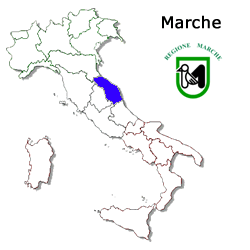 Information on Marche - Italy Information on Marche - Italy
 Ancona Ancona  Ascoli Piceno Ascoli Piceno  Macerata Macerata  Pesaro Pesaro  Urbino Urbino
Bordered by Umbria on one side and the Adriatic Sea on the other, Marche is partly mountainous, with land sloping from the mountains right down to the sea. Tourists flock to Marche's straight, smooth, sandy beaches, but the region's interior goes largely ignored. The Adriatic offers an outstanding variety of blue fish and crustaceans, some of which are rare and can only be found on this coast.
Not surprisingly, two of this area's specialties are fish soup, brodetto, and muscioli alla marinara, mussels spread over a pan and cooked over the fire. Second only to fish is popularity is pork, which is the centerpiece of many central Italian meals. The Marchigiani claim to be the originators of Porchetta, a boned, spit-roasted pig flavored with fennel and garlic.
Pasta, notably maccheroncini and tagliatelle, has an important tradition in Marche. Pastificio Latini produces some of the best artisanal pasta in the Marche tradition. Mushrooms grow in abundance in this area. Three kinds of truffles are also found in Marche; the white ones rival those from Alba. Cauliflowers from the Marches are famous throughout Italy. And the fruit--apples, peaches, figs and cherries-- are rich and luscious, a testament to the fertility of the soil.
 We welcome inquiries for available accommodations for the region of Marche and surrounding areas. Contact us for listing requirements. (Hotels - Motels - Villas - Bed & Breakfast - Condo Rentals, Agriturismo & all related accommodations) We welcome inquiries for available accommodations for the region of Marche and surrounding areas. Contact us for listing requirements. (Hotels - Motels - Villas - Bed & Breakfast - Condo Rentals, Agriturismo & all related accommodations)
|
| |
|
| |
Ascoli Piceno
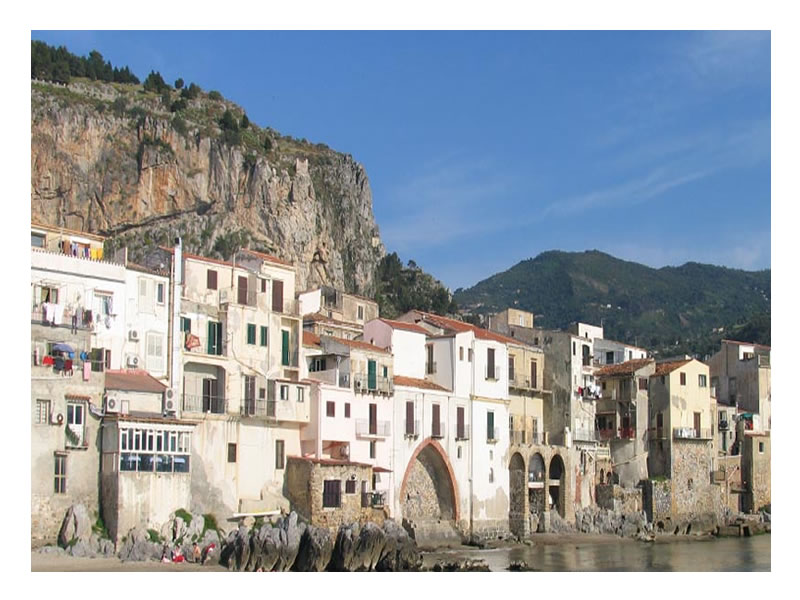 Ascoli Piceno lays at the confluence of Tronto River with Castellano Creek and is surrounded on three sides by mountains. Two natural parks are located on the north-western flank ( Parco Nazionale dei Monti Sibillini ) and on the south ( Parco Nazionale dei Monti della Laga ). Ascoli is well connected by railway to the Adriatic coast and the city of San Benedetto del Tronto and by highway to Rome and d'Ascoli . Ascoli Piceno lays at the confluence of Tronto River with Castellano Creek and is surrounded on three sides by mountains. Two natural parks are located on the north-western flank ( Parco Nazionale dei Monti Sibillini ) and on the south ( Parco Nazionale dei Monti della Laga ). Ascoli is well connected by railway to the Adriatic coast and the city of San Benedetto del Tronto and by highway to Rome and d'Ascoli .
The central historical part of the city is built in marble called travertino , a grey hued stoned extracted from the surrounding mountains. Its central Renaissance square, Piazza del Popolo ("Square of the People") is considered one of the most beautiful in Italy. According to the traditions, Ascoli Piceno was home to more than two hundred towers in the Middle Ages: today some fifty can still be seen.
 What to taste: What to taste:
• Olive oil is used regularly in this region to enhance the dishes and is the key element to their tasty cuisine.
• The egg pastas are among the leading dishes, from simple tagliatelle to Campofilone maccheroncini and chitarrine. Amongst the pasta there is also spaghetti in tuna sauce, green olives and tomatoes.
• There are soups made with cereal or pulses from the nearby mountains such as wheat, lentil or bean.
• There are the renowned local olives, which are stuffed with meat, liver and tomatoes and then deep-fried.
• The local wines include Rosso Piceno, Rosso Piceno Superiore and the Bianco Falerio dei Colli Ascolani.
 Cities & Towns: Cities & Towns:
 Coming soon Coming soon
 What to do: What to do:
• Nature lovers will love hiking along the trails of the Sibillini Mountains or wander around the villages, churches and historical landmarks.
•
Bicycle holidays are available that combine the beauty of nature with the pursuit of the sport, discovering the territory and traditional cuisine along the way.
• Many routes, both on- and off- road, have been designed to explore this varied environment, ranging from the mountains to the sea, with many climbs and descents, woods and rocky areas, all passing through breathtaking views.
• Acquasanta Terme is the ideal place to refresh body and soul at a thermal spa used by the Romans, now with all the modern comforts.
 Places to visit: Churches, Museums, Ruins, Piazzas, Fountains, Places to visit: Churches, Museums, Ruins, Piazzas, Fountains,
• The Cathedral of Sant'Emidio, housing an altarpiece by Carlo Crivelli , who lived and worked in and around the city for many years.
• The Gothic-style church of St. Francis (begun in 1258). The dome was completed in 1549. In the side portal is the monument to Pope Julius II , while the central portal is one of the most fine example of local travertine decoration. Annexed to the church is the 16th century Loggia dei Mercanti , in Bramantesque style.
• The Romanesque San Vittore (known from 996) with an essential façade and a low bell tower.
• St. Augustinus (14th century). Built with a single nave, was enlarged with two aisles in the late 15th century. The rectangular façade has a 1547 portal similar to that of St. Emidio.
• The convent houses, the Towns Library, the Contemporary Art Gallery and an auditorium.
• The convent of San Domenico, now a school, has a Renaissance cloister with 17th century frescoes. St. Peter Martyr (13th century), with a 1523 side portal by Cola d'Amatrice. The interior contains the precious reliquiary of the Holy Thorn, a gift of Philip IV of France .
• San Tommaso (1069), housing numerous art works and built with parts from the neighbouring Roman amphitheater.
• The Franciscan convent, of which two noteworthy cloisters remain today. It was once a prestigious center of culture, whose students included Pope Sixtus V .
• The Palazzo dei Capitani del Popolo ("Palace of the People's Captains"). Built in the 13th century connecting three pre-existing edifices, it was the seat of the podestà , the people's captains and, later, the Papal governors. In the 15th century the southern side was enlarged, and, in 1520, a Mannerist façade was added in the rear side. In 1535 it went under a general renovation, and in 1549 a new portal, with a monument of Pope Paul III , was added.
 Events: Events:
• Coming soon.
 Tours avaiable in the region: Tours avaiable in the region:
 Accomodations in close proximity: Hotels, Restorts, Holiday Houses, Condo Rentals, Farm Holidays (Agritourismo), Accomodations in close proximity: Hotels, Restorts, Holiday Houses, Condo Rentals, Farm Holidays (Agritourismo),
 Flights - Car Rentals - Cruises: Flights - Car Rentals - Cruises:
 Restaurants in close proximity: Restaurants in close proximity:
• (Add a restaurant review in the italian blog area of our website).
|
|
| |
Macerata
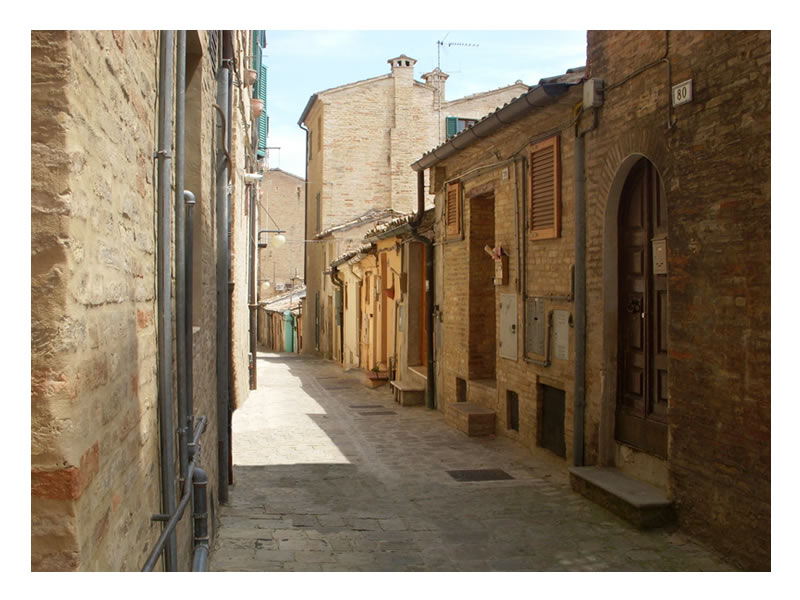 Macerata is situated on a hill between the Potenza and Chienti rivers, south of Ancona. The town was built in the 10th and 11th centuries near the ruins of the ancient Roman town of Helvia Recina, which was destroyed about 408 by the Visigothic king Alaric. A commune in the 12th century and the seat of a bishop from 1320, Macerata passed to the Papal States about 1445. Noteworthy buildings in the city include the Loggia dei Mercanti (1485–91), the Neoclassical Sferisterio (originally a sports arena; now an open-air opera venue), the cathedral (1771–90), Macerata is situated on a hill between the Potenza and Chienti rivers, south of Ancona. The town was built in the 10th and 11th centuries near the ruins of the ancient Roman town of Helvia Recina, which was destroyed about 408 by the Visigothic king Alaric. A commune in the 12th century and the seat of a bishop from 1320, Macerata passed to the Papal States about 1445. Noteworthy buildings in the city include the Loggia dei Mercanti (1485–91), the Neoclassical Sferisterio (originally a sports arena; now an open-air opera venue), the cathedral (1771–90),
 What to taste: What to taste:
• The local cuisine is simple and tasty and includes a lasagna and meat sauce.
• A traditional delicacy is a lean, pork-meat salami, finely minced and seasoned with garlic and pepper.
•
A typical and tasty dish is the 'Porto Recanati brodetto', a fish soup where the broth is obtained by pre-cooking cuttlefish with saffron.
• Desserts include biscotti col mosto and the area's 'crescia fogliata'.
• Local wines include the Bianco dei Colli Maceratesi, the celebrated Verdicchio di Matelica, also spumante, and the Vernaccia di Serrapetrona.
 Cities & Towns: Cities & Towns:
 Coming soon Coming soon
 What to do: What to do:
• The Sibillini Mountains offers numerous trails for trekking, horseback riding and mountain biking.
• There is fine off-piste skiing in the Azzurri Mountains, which the poet Leopardi could see from his window in Recanati.
• For those looking to just relax, the area offers thermal spas in Sarnano and Tolentino.
• Macerata, with its countless theatres and amazing productions, will not disappoint those keen on drama and opera.
 Places to visit: Churches, Museums, Ruins, Piazzas, Fountains, Places to visit: Churches, Museums, Ruins, Piazzas, Fountains,
• At the heart of Macerata, and where you will soon find yourself, is the Piazza della Liberta with its impressive merchants hall - the 16th century arcaded Loggia dei Mercanti. The 18th century theatre is just across the square - be sure to check if anything is playing during your visit.
• The surrounding streets also contain a number of impressive small palaces and buildings - stroll especially along the streets of Corso Matteotti and Corso della Repubblica.
• There is a cluster of interesting museums in the Pinacoteca Civica in the Piazza Vittorio Veneto at the south-west of Macerata, including some fine art works, both Renaissance and modern.
• The region around the foot of the hill has rather given way to new developments and industry in the (quite separate) new town, and is of less interest to visitors.
• A few kilometres north of Macerata are the Roman ruins of Helvia Recina, the Roman town that stood nearby.
 Events: Events:
• The theatrical season reaches its peak with the 'Rassegna Nazionale d'Arte Drammatica A. Perugini' and the celebrated opera season held at the Sferisterio.
• Equally well known is the Macerata Jazz Festival. Speaking of music, the Recanati Music Festival must not be forgotten, a coveted objective for young singer-songwriters.
Sarnano hosts the Mostra Mercato Nazionale dell'Antiquariato Artistico, the national antique trade fair, whereas in August, historical re-enactments bring a medieval atmosphere to the streets.
• In Tolentino, there is a re-enactment of the famous 1815 battle between the army of Gioacchino Murat and the Austrians. The town also hosts the 'Biennale Internazionale dell'Umorismo nell'Arte', the international exhibition of humor in art, with a display of the works at the International Humor Museum.
• Among the most unique events, there is the 'Disfida del bracciale' or the bracelet challenge, a 19th century re-enactment held in Treia. The districts compete against each other, each representing a different social class: the noble, the bourgeoisie, the farmers and the gypsies of the community that once lived nearby. Music and dance accompany the event.
The old amphitheatre in Urbisaglia is the splendid setting for works by Plautus, Aristophanes, Aeschylus, Euripides and Sophoocles.
 Tours avaiable in the region: Tours avaiable in the region:
 Accomodations in close proximity: Hotels, Restorts, Holiday Houses, Condo Rentals, Farm Holidays (Agritourismo), Accomodations in close proximity: Hotels, Restorts, Holiday Houses, Condo Rentals, Farm Holidays (Agritourismo),
 Flights - Car Rentals - Cruises: Flights - Car Rentals - Cruises:
 Restaurants in close proximity: Restaurants in close proximity:
• (Add a restaurant review in the italian blog area of our website).
|
|
| |
Pesaro
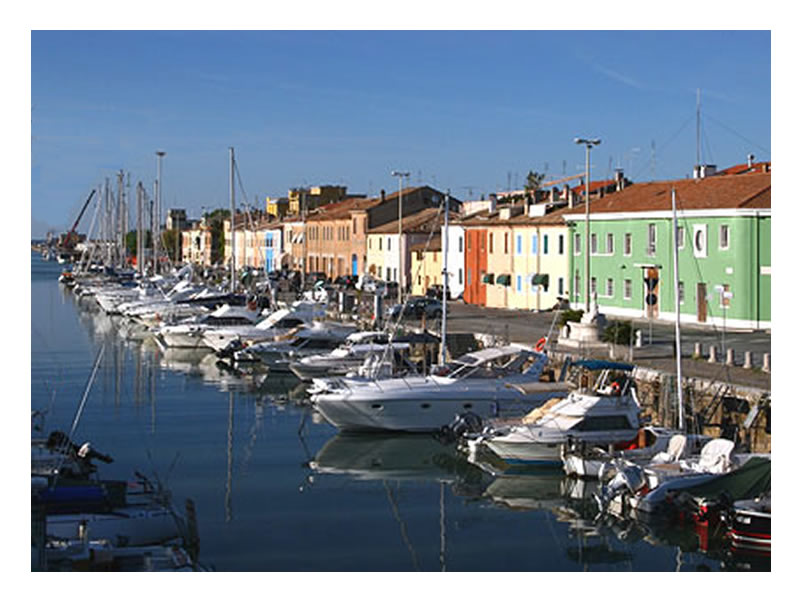 Pesaro was founded as Pisaurum by the Romans in 184 BC as colony in the territory of the Piceni, the people who lived in the Marche during the Iron Age. A settlement of the latter tribe, one of their most ancient, has been found at Novilara. Pesaro was founded as Pisaurum by the Romans in 184 BC as colony in the territory of the Piceni, the people who lived in the Marche during the Iron Age. A settlement of the latter tribe, one of their most ancient, has been found at Novilara.
The northern Piceni were invaded in the 4th century BC by the Senones Gauls, and when the Romans reached the are the population was a mix of the two races.
Under the Roman administration Pesaro, a hub across the Via Flaminia, became an important center of trading and craftmanship. After the fall of the Western Empire, Pesaro was occupied by the Ostrogoths, and destroyed by Vitigis (539) in the course of the Gothic War. Hastily rebuilt five years later after the Byzantine reconquets, it formed the so-called Pentapolis, part of the Exarchate of Ravenna. After the Lombard and Frank conquests of that city, Pesaro became part of the Papal States.
During Renaissance it was ruled by the Malatesta (1285-1445), Sforza (1445-1512) and Della Rovere (1513-1631). Under the latter family, who elected it as capital of their duchy, Pesaro lived its most flourishing age, with the construction of numerous public and private palaces, while a new line of walls (the Mura Roveresche) was erected.
On December 11, 1860 the Piedmontese troops entered the city, and Pesaro was subsequently annexed to the new Kingdom of Italy.
 What to taste: What to taste:
• A specialty in Pesaro is tournedos alla Rossini, a braised fillet with ham, mushrooms, parsley, lemon and pepper.
• The region also offers many kinds of meat, cheese, cured meats and sausages.
• There is also truffles (white and black); together with mushrooms.
 Cities & Towns: Cities & Towns:
 Coming soon Coming soon
 What to do: What to do:
• The Pesaro province provides a striking landscape, well suited to those who love the sea. Beautiful, remote coves at the foot of San Bartalo and Ardizio, with its seaside lifestyle that is ideal for families and those who want to get away from mass tourism without sacrificing fun and entertainment.
• There are the beaches of Marotta. Between Pesaro and Fano, where the beach is widest, the cliffs that ring the coastline create safe coves for children.
• The area offers countless opportunities for aquatic sports such as sailing and windsurfing, while there are alternatives for those who prefer to mix the seaside with the appreciation of the green of the countryside.
 Places to visit: Churches, Museums, Ruins, Piazzas, Fountains, Places to visit: Churches, Museums, Ruins, Piazzas, Fountains,
• You'll be able to trace the city's ancient history through the remains of Iron Age, Italic, Greek, Etruscan and Roman settlements in the Oliveriano Archeological Museum and marvel at the city's rich artistic heritage by visiting the Civic Museum, full of paintings and ceramic work.
• Wandering through the city, you'll see the 15th century castle constructed by the powerful Sforza family, along with the elegant Palazzo Ducale. Many people love to marvel at the 18th century Palazzo Olivieri, home to one of the most prestigious conservatories in all of Italy and possibly the world.
• Take a break from sightseeing and walk along the coast, where Pesaro presents itself as a "garden city", complete with green spaces and even splendid beaches.
• Take a stroll to the port area, and if you're visiting Pesaro in the summer, be sure to catch a ride on a boat that will give you the tour of the coast.
 Events: Events:
• Among the historical re-enactments not to be missed is the reconstruction of the feats of the Della Rovere family in Mondavio with the 'Palio of the Wild Boar', during which representatives from the three districts challenge one another.
• The Carnevale di Fano has ancient roots, where the floats parade through music, lights and colours, handing out candies and chocolates. The symbolic element of the event is the 'vulon', a mask that represents the most notable people of the town.
• In Gradara, there is the so-called 'Seduction at the castle', a game between knights and dames with shows and re-enactments, while in Cagli there is the 'Palio of the Goose', a celebration in Renaissance costumes.
 Tours avaiable in the region: Tours avaiable in the region:
 Accomodations in close proximity: Hotels, Restorts, Holiday Houses, Condo Rentals, Farm Holidays (Agritourismo), Accomodations in close proximity: Hotels, Restorts, Holiday Houses, Condo Rentals, Farm Holidays (Agritourismo),
 Flights - Car Rentals - Cruises: Flights - Car Rentals - Cruises:
 Restaurants in close proximity: Restaurants in close proximity:
• (Add a restaurant review in the italian blog area of our website).
|
|
| |
Urbino
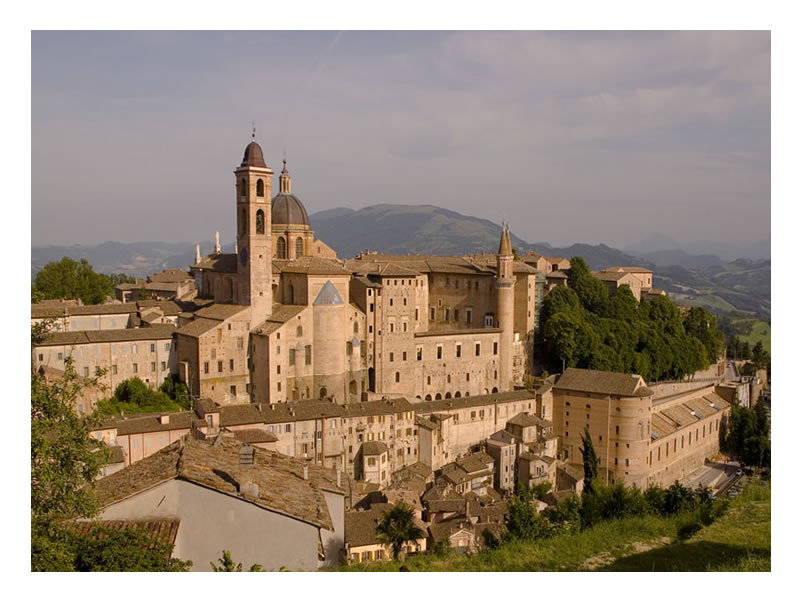 Urbino is a walled city in the Marche region in Italy southwest of Pesaro, a World Heritage Site notable for a remarkable historical legacy of independent Renaissance culture, especially under the patronage of Federico da Montefeltro, duke of Urbino from 1444 to 1482. Urbino is a walled city in the Marche region in Italy southwest of Pesaro, a World Heritage Site notable for a remarkable historical legacy of independent Renaissance culture, especially under the patronage of Federico da Montefeltro, duke of Urbino from 1444 to 1482.
Urbino remains one of the most important towns in the Marche - indeed in Italy - for the tourist in search of great Italian art and architecture and its beguiling streets well reward the curious traveller.
The town, nestled on a high sloping hillside, retains much of its picturesque medieval aspect, only slightly marred by the large car parks below the town. It hosts the University of Urbino, founded in 1506, and is the seat of the Archbishop of Urbino. Its best-known architectural piece is the Palazzo Ducale, rebuilt by Luciano Laurana.
 What to taste: What to taste:
• If you love cobbled streets, terra-cotta roofs, provincial cuisine made with lamb, rabbit, swine, and cheese, you may just love Urbino. This hill town lies nestled in the calf of the boot that is Italy, in a region known as Le Marche (MAHR-kay). Divided into four provinces - Pesaro-Urbino to the north, Ancona, Macerata and Ascoli Piceno to the south - the Marche extends from the Adriatic coast in the east to the Sibillini Mountain chain of the Appenines in the west. From north to south, the region is characterized by gently rolling hills and fertile valleys that run east to west from the sea to the mountains.
 Cities & Towns: Cities & Towns:
 Coming soon Coming soon
 What to do: What to do:
• In Urbino, you will find food, history, atmosphere, frescoes, and orange light off clay tile. Best of all, you will experience all this without the crowds of Tuscany.
• From north to south, the region is characterized by gently rolling hills and fertile valleys that run east to west from the sea to the mountains.
 Places to visit: Churches, Museums, Ruins, Piazzas, Fountains, Places to visit: Churches, Museums, Ruins, Piazzas, Fountains,
• Palazzo Ducale Ducal Palace Tel. +39 0722 322625 Opening hours: monday 8.30 - 14.30 (last ticket 12.30); tuesday - sunday and public holidays 8.30 - 19.15 (last ticket 18.15); closed 25th December, 1st January, 1st May Entrance fee €4/ €2 (concession)
• Casa Natale di Raffaello Raffaello's place of birth Tel. +39 0722 320105 Opening hours: 9.00 - 13.00 and 15.00 - 19.00; public holidays 10.00 - 13.00; closed 25th December, 1st JanuaryEntrance fee €3/ Groups of 15+ pax €2
• Oratorio San Giovanni Oratory of San Giovanni Tel. +.39 3476711181 Opening hours: 10.00 - 12.30 and 15.00 - 17.30; closed 25th December, 1st January Entrance fee €2/ Groups of 15+ pax €1.50
• Oratorio San Giuseppe Oratory of San Giuseppe Tel. +39 3476711181 Opening hours: 10.00 - 12.30 and 15.00 - 17.30; closed 25th December, 1st January Entrance fee €2/ Groups of 15+ pax €1.50
• Duomo Cathedral Opening hours: 8.00 - 12.00 and 14.30 - 18.30 Free entrance
• Museo Albani Albani Museum Piazza Pascoli 2 Tel. +39 0722 2850 Opening hours: 9.00 - 12.00 and 14.30 - 18.00 Entrance fee €2
• Chiesa di San Francesco San Francesco Church Tel. +39 0722 328764 Opening hours: 7.00 - 12.30 and 15.00 - 19.00 Free entrance
• Mausoleo dei Duchi Dukes Mausoleum Chiesa di San Bernardino 2km from the centre Tel. +39 0722 320539 Opening hours: 8.00 - 18.00 Free entrance
• Parco della Resistenza Panoramic view Fortezza Albornoz Opening hours: 9.00 - 18.00 Free entrance
• Botanic gardens Via Bramante Tel. +39 0722 2428 Opening hours: 9.00 - 12.30 and 15.30 - 17.00; closed on, thursday and saturday afternoon and public holidays Free entrance
 Events: Events:
• Coming soon.
 Tours avaiable in the region: Tours avaiable in the region:
 Accomodations in close proximity: Hotels, Restorts, Holiday Houses, Condo Rentals, Farm Holidays (Agritourismo), Accomodations in close proximity: Hotels, Restorts, Holiday Houses, Condo Rentals, Farm Holidays (Agritourismo),
 Flights - Car Rentals - Cruises: Flights - Car Rentals - Cruises:
 Restaurants in close proximity: Restaurants in close proximity:
• (Add a restaurant review in the italian blog area of our website).
|
Home | Advertising Information | Contact Us
Copyright ©2002 Italian Recipes Trinakria Development. All rights
reserved. |
 |
|
 |


 Information on Marche - Italy
Information on Marche - Italy Ascoli Piceno lays at the confluence of Tronto River with Castellano Creek and is surrounded on three sides by mountains. Two natural parks are located on the north-western flank ( Parco Nazionale dei Monti Sibillini ) and on the south ( Parco Nazionale dei Monti della Laga ). Ascoli is well connected by railway to the Adriatic coast and the city of San Benedetto del Tronto and by highway to Rome and d'Ascoli .
Ascoli Piceno lays at the confluence of Tronto River with Castellano Creek and is surrounded on three sides by mountains. Two natural parks are located on the north-western flank ( Parco Nazionale dei Monti Sibillini ) and on the south ( Parco Nazionale dei Monti della Laga ). Ascoli is well connected by railway to the Adriatic coast and the city of San Benedetto del Tronto and by highway to Rome and d'Ascoli . Macerata is situated on a hill between the Potenza and Chienti rivers, south of Ancona. The town was built in the 10th and 11th centuries near the ruins of the ancient Roman town of Helvia Recina, which was destroyed about 408 by the Visigothic king Alaric. A commune in the 12th century and the seat of a bishop from 1320, Macerata passed to the Papal States about 1445. Noteworthy buildings in the city include the Loggia dei Mercanti (1485–91), the Neoclassical Sferisterio (originally a sports arena; now an open-air opera venue), the cathedral (1771–90),
Macerata is situated on a hill between the Potenza and Chienti rivers, south of Ancona. The town was built in the 10th and 11th centuries near the ruins of the ancient Roman town of Helvia Recina, which was destroyed about 408 by the Visigothic king Alaric. A commune in the 12th century and the seat of a bishop from 1320, Macerata passed to the Papal States about 1445. Noteworthy buildings in the city include the Loggia dei Mercanti (1485–91), the Neoclassical Sferisterio (originally a sports arena; now an open-air opera venue), the cathedral (1771–90),  Pesaro was founded as Pisaurum by the Romans in 184 BC as colony in the territory of the Piceni, the people who lived in the Marche during the Iron Age. A settlement of the latter tribe, one of their most ancient, has been found at Novilara.
Pesaro was founded as Pisaurum by the Romans in 184 BC as colony in the territory of the Piceni, the people who lived in the Marche during the Iron Age. A settlement of the latter tribe, one of their most ancient, has been found at Novilara.  Urbino is a walled city in the Marche region in Italy southwest of Pesaro, a World Heritage Site notable for a remarkable historical legacy of independent Renaissance culture, especially under the patronage of Federico da Montefeltro, duke of Urbino from 1444 to 1482.
Urbino is a walled city in the Marche region in Italy southwest of Pesaro, a World Heritage Site notable for a remarkable historical legacy of independent Renaissance culture, especially under the patronage of Federico da Montefeltro, duke of Urbino from 1444 to 1482.